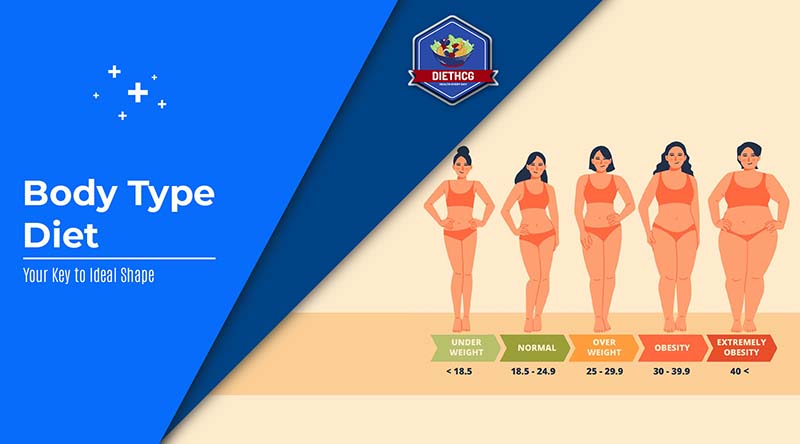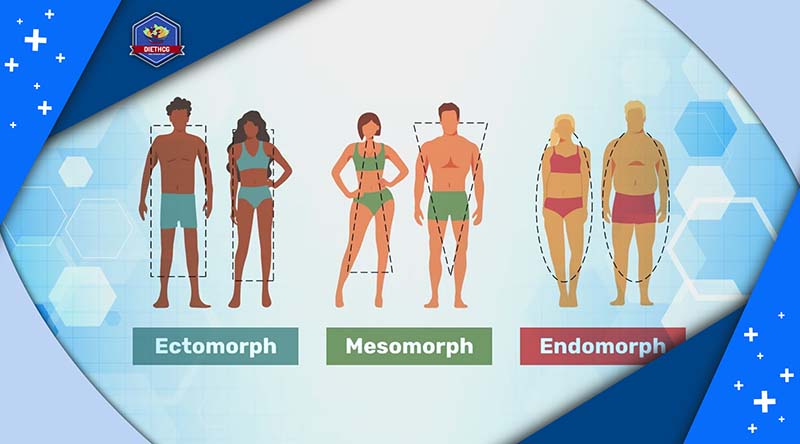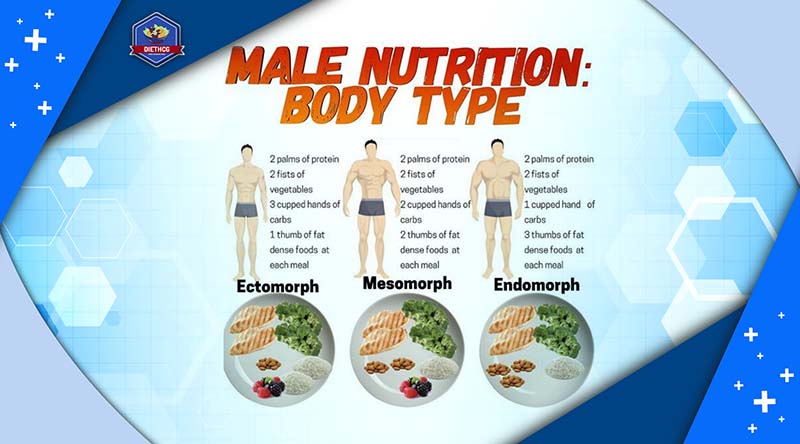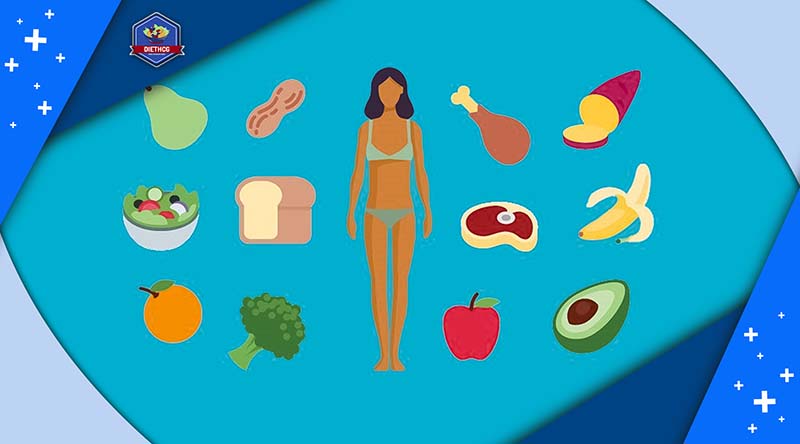Stand in front of a mirror and observe your unique body shape. This understanding is crucial for identifying a suitable diet for body type and exercise routine, based on the body type diet concept. This approach, originating in the 1940s, suggests tailoring nutrition and workouts to your body type to improve fuel utilization and support weight loss. Let’s explore with DietHCG the effectiveness of this strategy in today’s health and fitness landscape, setting aside stereotypes.

1. The Importance of Body Type in Your Diet Plan
The link between an individual’s somatotype—essentially, their body type—and the effectiveness of their diet and workout routines isn’t extensively documented through research. However, there are studies that shed light on the impact of body composition differences.
A notable study involving 63 men aged between 18 and 40 years old discovered that participants with longer, leaner physiques had lower body fat, weighed less, and possessed less lean muscle mass compared to those with curvier or hourglass-shaped bodies.
Furthermore, an analysis of three-day food journals from nearly 150 women over the age of 57 revealed a correlation between body type and various health indicators, including dieting behaviors, physical activity levels, weight fluctuation, Body Mass Index (BMI), and even disease presence. Interestingly, those with curvier figures showed higher diastolic blood pressure compared to their lean and hourglass-shaped counterparts. Additionally, curvy individuals were found to consume more protein, while the leanest participants had the lowest average protein intake.
Phil Catudal, a well-known fitness trainer and co-author of “Just Your Type: The Ultimate Guide to Eating and Training Right for Your Body Type,” emphasizes the importance of understanding your predominant body type (noting that many people exhibit characteristics of more than one type) in establishing health habits that align well with your body’s needs.
This knowledge not only aids in setting achievable goals but also ensures that your efforts yield optimal results. According to Catudal, copying the regimen of someone with a different body structure might not produce the same outcomes for you. Recognizing and respecting your body’s unique needs can lead to a more personalized and effective approach to diet and exercise.
Note: It’s crucial to approach body type theories with a balanced perspective, considering them as one of many tools in your health and wellness toolkit. Personal experimentation and adaptation are key to finding what truly works for your individual health journey.
2. Understanding Your Body Type: Key Characteristics of Common Body Shapes
Body types categorize individuals based on their composition of body fat, bone density, and muscle mass. These are broadly classified into three somatotypes: ectomorph, mesomorph, and endomorph. Identifying your body type can be a stepping stone towards tailoring your diet and exercise regimen for optimal health and performance.
Ectomorphs, with their slender builds, narrow frames, and small joints, resemble distance runners or ballerinas. They may appear slim but can carry hidden body fat, a challenge compounded by their fast metabolism hindering muscle gain.
Endomorphs tend to have a higher percentage of body fat and muscle, coupled with a robust bone structure, smaller shoulders, and relatively shorter limbs. This body type is often seen in individuals like football linemen or shot put throwers, as well as those with a curvier figure. Endomorphs may find it easy to gain weight, especially around the lower belly and hips, and challenging to shed it, partly because their bodies are more inclined to convert high-carbohydrate foods into fat.
Mesomorphs have athletic, muscular physiques with wide shoulders and a narrow waist, typical of sprinters and soccer players. They naturally excel in muscle growth and weight management. Mesomorphs excel in physical activities and can both gain and lose weight effectively, making them well-suited for muscle-building exercises.

3. How Your Body Type Influences Your Diet
Gaining insight into your somatotype—whether you’re an ectomorph, mesomorph, or endomorph—can be a crucial step in identifying the optimal nutritional approach for your body’s needs. According to fitness expert Phil Catudal, understanding your body type can not only help tailor your diet for better fuel efficiency but also enhance your weight loss efforts, if that’s a goal. One significant advantage of the body type diet is its healthiness and its potential to divert you from extreme, and often ineffective, dieting measures that can have adverse effects.
According to Catudal, aligning your diet with your body type sets realistic expectations for physical changes, which depend on your investment of time and effort. It’s essential to recognize that aiming for a particular body aesthetic, like chiseled abs, might not align with your natural body structure—and that’s perfectly acceptable. Contrary to widespread beliefs propagated by popular culture, there isn’t a one-size-fits-all diet. Prioritizing your health over conforming to an idealized image is more beneficial in the long run.
Working with your body type can also empower you to leverage your strengths and accept your limitations, thereby reducing frustration and maximizing your potential. Marta Montenegro, a certified strength and conditioning specialist, highlights that recognizing your somatotype can adjust your expectations and strategies—for example, endomorphs, who might find shedding weight more challenging, can benefit from knowing this and modifying their diet, such as by lowering carbohydrate intake, to address their specific needs. Understanding your body type can mitigate the common frustrations associated with weight loss by setting realistic expectations and customizing your approach to diet and exercise.
4. Crafting a Body Type Diet: Meal Planning for Your Unique Shape
Tailoring your diet to suit your body type can significantly enhance your ability to achieve your body composition goals. Understanding whether you’re an ectomorph, mesomorph, or endomorph provides insight into your metabolic rate and hormonal profile, which in turn influences how your body processes nutrients. Here’s how to adjust your meal planning according to each body type’s specific needs.
Ectomorph Nutritional Focus: Ectomorphs, characterized by a fast metabolism due to their thyroid dominance, often find themselves hungry and may struggle to gain weight. Their diet should be rich in carbohydrates to match their high basal metabolic rate (BMR). A higher intake of complex carbohydrates, balanced with moderate amounts of protein and healthy fats, supports their energy needs without leading to rapid hunger spells. Avoid simple and highly processed carbs that can cause quick hunger returns and contribute to a “skinny fat” physique. For ectomorphs, focusing on whole, unrefined carbs along with sufficient protein and fats is key to maintaining a healthy body composition.
Mesomorph Nutritional Strategy: Mesomorphs, naturally athletic and muscular, require a diet that supports their higher calorie needs for muscle maintenance and growth within the mesomorph body type diet framework. A balanced intake of proteins, fats, and complex carbohydrates fuels their workouts and muscle recovery in the mesomorph body type diet. Mesomorphs benefit from consuming a mix of all macronutrients in their mesomorph body type diet, with an emphasis on protein to support their muscle-building capabilities. It’s important for mesomorphs to be mindful of hidden sugars in foods like yogurt, sauces, and some “natural” peanut butters, as these can affect body composition and health within the context of the mesomorph body type diet.
Endomorph Dietary Guidelines: Endomorphs, who have a slower metabolism and a higher propensity to store carbohydrates as fat, should aim for a balanced distribution of macronutrients with a slight reduction in carbohydrate intake in their endomorph body type diet. Prioritizing proteins and healthy fats while consuming carbohydrates primarily from vegetables and whole grains can help manage insulin sensitivity and reduce the risk of diabetes in the endomorph body type diet. Low-carb or ketogenic diets, which are part of the endomorph body type diet, might be beneficial, focusing on monounsaturated and omega-3 fats to promote satiety and manage weight. Endomorphs should limit high-glycemic foods like bread, pasta, and sugary fruits in their endomorph body type diet to avoid blood sugar spikes.

5. Body Type Diet: Sample Menus Tailored to Different Body Shapes
While the concept of the body type diet is intriguing, it’s crucial to understand that the scientific community has not provided strong evidence for its effectiveness. The following meal plans are inspired by the recommendations of Phil Catudal and reflect the dietary advice found in his book. These sample menus are designed to cater to the distinct nutritional needs of ectomorphs, mesomorphs, and endomorphs, based on their unique body compositions.
Ectomorph 1-Day Sample Menu: Ectomorphs should focus on a diet with a macronutrient ratio of approximately 45% carbohydrates, 35% protein, and 20% fat. This distribution supports their high metabolic rate and provides sufficient energy and nutrients for muscle maintenance and growth.
- Breakfast: Oatmeal topped with a variety of fruits and a handful of nuts for added protein and healthy fats.
- Snack: A protein shake to fuel your body between meals.
- Lunch: A hearty salad packed with chopped vegetables, topped with grilled chicken for protein, dressed with a light vinaigrette.
- Snack: An apple paired with a serving of almonds to keep you satisfied until dinner.
- Dinner: Grilled shrimp and broccoli served over a bed of quinoa for a well-rounded, nutrient-rich meal.

Mesomorph 1-Day Sample Menu: Mesomorphs benefit from a balanced macronutrient intake, distributing their calories relatively evenly across carbohydrates, proteins, and fats.
- Breakfast: Whole-grain toast with scrambled eggs for a balanced start to the day.
- Snack: A protein bar and a piece of fruit to maintain energy levels.
- Lunch: A vibrant salad with mixed chopped veggies and chickpeas, dressed with your choice of dressing for a mix of macros.
- Snack: Veggies paired with hummus for a fiber-rich, protein-packed snack.
- Dinner: A serving of chicken breast with roasted vegetables and a side of sweet potato for a satisfying, nutritious meal.

Endomorph 1-Day Sample Menu: Endomorphs should aim for a macronutrient distribution of 20% carbohydrates, 40% protein, and 40% fat, focusing on high protein and lower carbohydrates to support fat loss.
- Breakfast: Scrambled eggs mixed with spinach for a protein-rich start.
- Snack: A low-carb protein bar to keep hunger at bay.
- Lunch: Roasted turkey wrapped in lettuce for a low-carb, high-protein meal.
- Snack: A serving of vegetables dipped in hummus for a satisfying, nutrient-dense snack.
- Dinner: Grilled chicken served with zucchini noodles and a side of quinoa, balancing protein, carbs, and veggies perfectly.

6. Sticking to Your Body Type Diet: Tips and Advice for Success
To navigate the journey of a body type diet successfully, consider these practical tips and strategies designed to help you tailor your nutrition and fitness routine to your unique physique. These guidelines aim to optimize your health and progress towards your goals.
- Identify Your Body Type: Recognizing whether you’re an ectomorph, mesomorph, or endomorph is crucial. This knowledge allows you to customize your approach to diet and exercise, maximizing your body’s potential.
- Customize Your Diet: Adapt your eating habits to suit your body type. For example, endomorphs might benefit from a diet with higher protein and lower carbs. Mesomorphs, on the other hand, should balance their intake of proteins, carbs, and healthy fats according to their active lifestyle needs.
- Exercise Strategically: Select workouts that complement your body type’s strengths and weaknesses. Endomorphs, for instance, might find a combination of cardiovascular exercises and strength training for larger muscle groups to be effective. Mesomorphs can tailor their fitness routines to their specific objectives, whether for endurance, strength, or flexibility.
- Incorporate Regular Movement: Beyond structured workouts, find ways to stay active throughout the day. Combat sedentary habits by taking short walks, using the stairs, or engaging in light stretching sessions to keep the body energized and agile.
- Focus on Healthy Fats and Proteins: Ensure your diet includes sources of healthy fats such as nuts, seeds, olive oil, and avocados. Pair these with high-quality proteins and a variety of vegetables to create balanced, nutritious meals.
- Seek Professional Guidance: If you’re unsure where to start or need help customizing your diet and exercise plan, don’t hesitate to consult with a dietitian or a fitness expert. They can offer personalized advice based on your body type, lifestyle, and health goals.
- Commit to Consistency: The key to seeing results is consistency. Adhering to your tailored diet and exercise regimen diligently will gradually lead to improved health and body composition.
7. Conclusion
Exploring the body type diet reveals a key to unlocking personal health and fitness success: customization. By aligning your diet and exercise with your body type—ectomorph, mesomorph, or endomorph—you’re not just following a trend but embarking on a journey tailored to your unique needs. This approach offers a path away from generic, ineffective regimens toward more satisfying, results-oriented health practices. Embrace your individuality and optimize your wellness strategy.


